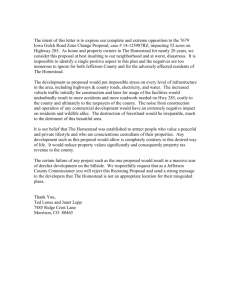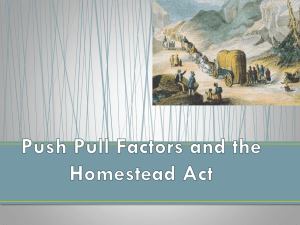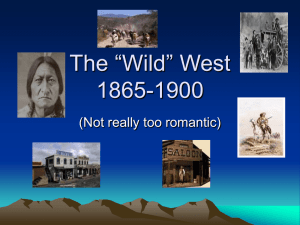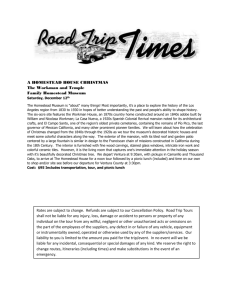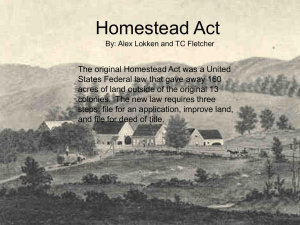Facilitator`s Guide
advertisement
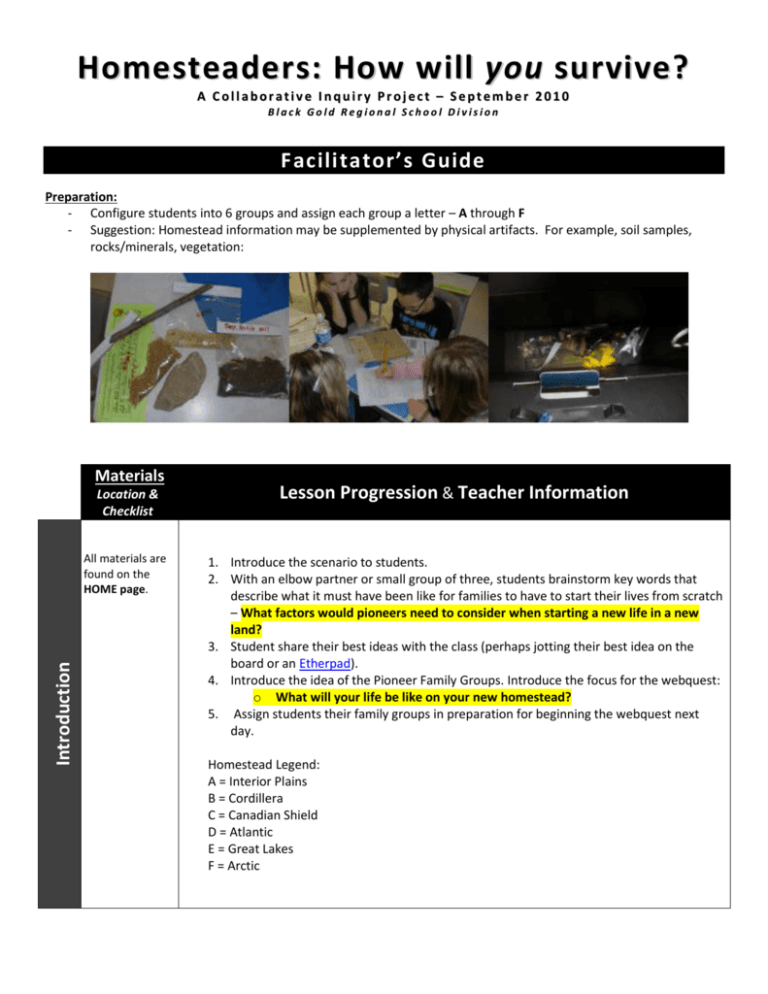
Homesteaders: How will you survive? A Collaborative Inquiry Project – September 2010 Black Gold Regional School Division Facilitator’s Guide Preparation: - Configure students into 6 groups and assign each group a letter – A through F - Suggestion: Homestead information may be supplemented by physical artifacts. For example, soil samples, rocks/minerals, vegetation: Materials Location & Checklist Introduction All materials are found on the HOME page. Lesson Progression & Teacher Information 1. Introduce the scenario to students. 2. With an elbow partner or small group of three, students brainstorm key words that describe what it must have been like for families to have to start their lives from scratch – What factors would pioneers need to consider when starting a new life in a new land? 3. Student share their best ideas with the class (perhaps jotting their best idea on the board or an Etherpad). 4. Introduce the idea of the Pioneer Family Groups. Introduce the focus for the webquest: o What will your life be like on your new homestead? 5. Assign students their family groups in preparation for beginning the webquest next day. Homestead Legend: A = Interior Plains B = Cordillera C = Canadian Shield D = Atlantic E = Great Lakes F = Arctic Step #1 – Learn About Your Homestead All materials are found on the individual family/homeste ad pages. Web resources may be supplemented with physical artifacts. Step #2 – Survival Plan All materials are found on the SURVIVAL PLAN page. NOTE: Student groups should not know the region where their homestead is located. They must deduce their location based on the geographical characteristics of their region. 1. Together with their group members, students will examine materials to learn about the geographical traits of their homestead land. As they look at the resources available for their homestead, students should discuss the question: In what region of Canada is my homestead located? Facilitation Suggestions: It may be helpful to have students take notes on the characteristics they notice about their region. That way, they have a hard copy of information to refer to during the next task. Please see the SURVIVAL PLAN page for the lesson progression. Facilitation Suggestions: #1 – Identify Homestead Region – Students may need to do additional research to identify the region in which their homestead is located. #2 - Where is my homestead? Handout – this is an opportunity to give comment-only feedback to students regarding their conclusions. Feedback may come in the form of written comments or a quick student/teacher conference. #3 – Build Criteria for Survival Plan – Together with an elbow partner or small group of 3, students brainstorm ideas for the question: What did pioneers need to plan for in order to survive? Student groups share ideas as a class – Teacher records ideas on the board. As a class, narrow ideas down into ESSENTIAL elements of a survival plan. Teacher transcribes the list onto a class poster and/or student handout so that they may use the criteria as a self-assessment checklist. o Example co-created criteria: Type of shelter/materials available in the area to build it Food/Water sources: Available plants/trees Animals found in the area Water sources (for drinking and transportation) What job will we do to survive in this area? Ex. farmer, miner, fisherman Climate – how does it affect our life? Plan needs to include ONLY stuff available in my region #4 Survival Plan Creation – Survival Plan Organizer is designed for students to identify the reasons for why they are making specific survival choices. ICT Connections: - Use VUE, Inspiration, or Etherpad for brainstorming o If students complete brainstorming electronically, they may be less likely to lose it. - ICT Extension: Students can create a list of keywords to assist their internet research. Step #3 – Presenting Pioneer Lifestyles All materials are found on the PRESENTATION PLAN page. Please see the PRESENTATION page for the lesson progression. Facilitation Suggestions: - #1 – Build Criteria for Presentation – Together with an elbow partner or small group of 3, students brainstorm ideas for the question: What makes a great presentation that shows our pioneer lifestyle? Student groups share ideas as a class – Teacher records ideas on the board. As a class, narrow ideas down into ESSENTIAL elements of a great presentation. Teacher transcribes the list onto a class poster and/or student handout so that they may use the criteria as a self-assessment checklist. NOTE: Teacher should tailor presentation criteria to coverage of Program of Studies learner outcomes. Please see the end of the Facilitator’s Guide for curriculum connections. Criteria can then be used to create a rubric for assessment. ASSESSMENT SUGGESTION: Students should be marked INDIVIDUALLY based on their personal contribution to the survival plan/presentation. Ex. Sally was responsible for making decisions about food and water sources, and also completes that part of the presentation. Sally’s mark should not be affected by her peers’ contributions to the presentation. NOTE: If the project format is open to student choice, students may choose the format that is most appropriate for their survival responsibilities (ex. diary format, photostory presentation, diorama and explanation, skit, etc.) Formative: Assessment Suggestions - - Build periodic opportunities for comment-only feedback into the project: o Peer collaboration o Structured student self-assessment activities; prompt students to show specific evidence from their work that proves their self-assessment is accurate o Quick conferences with teacher o Students submit draft work or worksheets for comment-only written feedback Assess student progress via co-creating criteria – Do the students seem to be identifying ideas that are on-track? Summative: - Assess the presentation in terms of whether or not the student demonstrates a deep understanding of the learning outcomes. - Assess the presentation in terms of whether or not the student demonstrates a deep understanding of the appropriate skills outcomes. - Use the co-created criteria lists to create an outcome-based assessment rubric o Distribute this rubric to students BEFORE summative assessment, and allow them to use the rubric to make changes to their work. Program of Studies – Social Studies 5 Connections 5.1.1 value Canada’s physical geography and natural environment: • appreciate the variety and abundance of natural resources in Canada (ER, LPP) • appreciate the diversity of geographic phenomena in Canada (LPP) • appreciate how the land sustains communities and the diverse ways that people have of living with the land (GC, LPP) 5.1.2 examine, critically, the physical geography of Canada by exploring and reflecting upon the following questions and issues: • How do landforms, bodies of water and natural resources affect the quality of life in Canada? (LPP) SKILLS OUTCOMES 5.S.1 5.S.1 develop skills of critical thinking and creative thinking: • generate original ideas and strategies in situations of individual and group activities 5.S.2 develop skills of historical thinking: • use photographs and interviews to make meaning of historical information 5.S.4 demonstrate skills of decision making and problem solving: • determine when a decision needs to be made in dealing with problems and issues • collaborate with others to apply strategies for decision making and problem solving � use data gathered from a variety of electronic sources to address identified problems 5.S.5 demonstrate skills of cooperation, conflict resolution and consensus building:• work collaboratively with others to achieve a common goal � retrieve data from available storage devices, such as a shared folder, to which a group has contributed 5.S.7 apply the research process: • draw and support conclusions, based on information gathered, to answer a research question � access and retrieve appropriate information from the Internet by using a specific search path or from given uniform resource locators (URLs)
